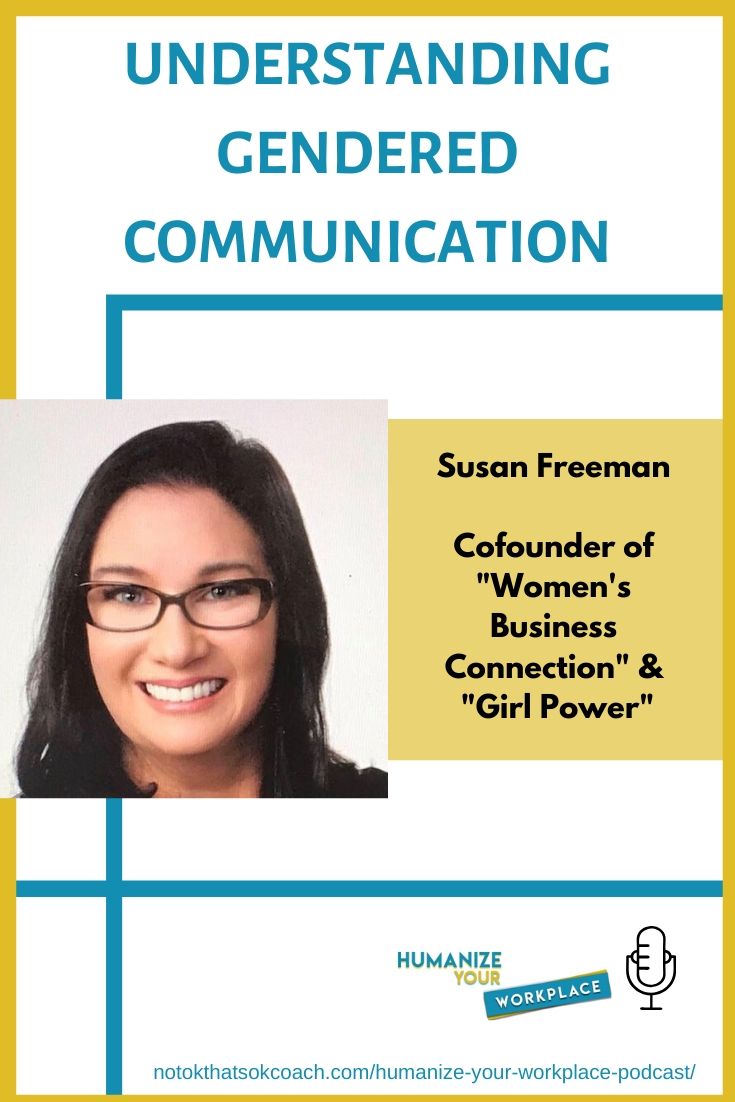On this week’s episode of Humanize Your Workplace, we are joined by Susan Freeman.
Susan’s goal is to help women in business communicate effectively with the world — and to help men communicate effectively with women in business!
Susan’s training draws on her experiences as a sales executive in the financial services industry, her business development and leadership training in the legal industry, and her graduate-level studies in Communication.
Susan’s passion for helping women succeed is long-standing. She co-founded “Women’s Business Connection” in Massachusetts and “Girl Power” with over 6,000 followers. She has also taught “Girls in Politics,” a program created to introduce girls to politics, policy, and the branches of government. Susan recently completed Cornell University’s “Institute for Women’s Entrepreneurship” program of studies. Her enthusiasm for the benefits of building meaningful relationships has made her a great connector and as such, she has over 15,000 followers on social media. As an ENFJ, she excels at building relationships and teaching others to do the same. She helps professionals communicate effectively in order to develop new business. She trains professionals to use client-centric insights to assess needs and identify solutions that meet strategic goals.
In this weeks episode we chat about:
- How women and men communicate differently
- How women can combat bias
- How women and men partner together in the workplace to help one another advance
To listen to this week’s episode, head over to Google Podcasts, Spotify, Apple Podcasts, or Stitcher, check it out below.
(1) In what ways do women and men communicate differently?
Body Language.
Men can be seen to keep themselves very much to themselves! While having a conversation, many men come across as serious and practical. Much of men’s communication is verbal, involving vocabulary and intonation. Women have another layer to their communication: non-verbal. Women tend to use gestures as visual aids while talking and use their facial expressions much more. Nodding our heads when listening, for example, is something that we typically do more than men. Using open body language and engaging our audience by ‘talking with our hands’ is another thing that more women than men tend to incorporate into a conversation.
Apologizing.
For women, apologizing is a way of forming and maintaining connections with people – it shows respect and humility. Many women understand that saying “sorry” can solve a lot of issues! “I’m sorry the project failed,” can bring emotional balance and establish a new starting point. Men often find apologizing harder than women, as it feels as though they are giving in. When they do apologize, it IS to take blame. They worry that they will be seen as weak for accepting blame and may feel as though their power or authority will be compromised by apologizing.
Compliments.
Men don’t tend to give out compliments as much as women do. If they do, they are normally aimed at a potential partner, rather than a friend or colleague. Women are much more likely than men to give out compliments. For us, it is way a forming a bond and showing respect. It is also a way of showing that we are on the same level. By complimenting someone, we show that they are not a threat and that they can be trusted. This links in with a woman’s desire to form connections and find commonalities.
(2) How can women combat bias?
Take the Implicit Associations Test.
The first step to changing our implicit biases is acknowledging that we have them. We can check our level of implicit bias by taking one (or several) of the Implicit Association Tests on Project Implicit.
Be curious.
Make an effort to be friendlier and act less threatened when interacting with people you perceive as different.
Become aware of your “positive stereotypes.”
Positive stereotypes may seem harmless but they can register as and feel offensive or restrictive to those on the receiving end. Example of Yang, Democratic presidential candidate, saying, “I’m Asian so I know a lot of doctors.
Resist the urge to judge other women.
Make an effort to assume the best of other women. Like you, they feel the extra pressure created by gender bias and are doing the best they can. If you hear someone suggesting they dislike a woman because she is aggressive or has “sharp elbows,” request a specific example of what the woman did and then ask, “Would you have the same reaction if a man did the same thing?”
Be direct to resolve conflict.
If you feel like another woman is undercutting you, don’t let it pass. Ignoring the problem only allows it to create more tension. Instead, ask for a private meeting with her and say, “It’s my perception—and I may be wrong—that sometimes you don’t view me in the best light. I’d really like to have a good relationship with you. Please help me understand if somehow we’ve gotten off on the wrong foot.”
Respect one another’s experiences.
Women from different generations sometimes judge one another harshly. Older women can feel that they paid their dues, so younger women should, too—without realizing that their trailblazing efforts are paving the way for the next generation to have a better experience. Younger women can think older women are overly assertive without realizing how hard they had to push to create a path for female leadership. Recognize that women have had different experiences and look for opportunities to understand and even celebrate those differences.
Collaborate with other women.
If you are in conflict with another woman, try to find a project you can collaborate on together. This works particularly well if the project can be done off-site, removing any environmental factors that may be contributing to your Tug of War. Mentoring programs and philanthropy efforts offer good opportunities to build positive working relationships.
Advocate for other women.
Women do not need to advocate for all women—after all, men don’t advocate for all men. That said, supporting other women is a good way to build your network and to live up to your ideals. For example, if you’re in a meeting and notice that a woman’s idea is ignored but a man is praised for the same idea later, say, “Great idea! I loved it when Sandra originally brought it up, and I’m glad you reiterated it.” In addition, if you see a woman doing more than her share of the office housework like taking notes or planning parties, help her find more career-enhancing work at your organization.
(3) What are some things that women and men can do to partner together in the workplace to help one another advance?
Prevent the viral spread.
When you hear a woman called “bossy” or “shrill,” request a specific example of what the woman did and then ask, “Would you have the same reaction if a man did the same thing?” In many cases, the answer will be no. Remember that you can also fall into these bias traps, so think carefully about your own response to female coworkers.
Awareness begets fairness.
Make sure everyone on your team is aware of the gender bias in evaluating performance. Be specific about what constitutes excellent performance, and make sure goals are set in advance, understood, and measurable. The clearer your criteria are, the better. Be prepared to explain your evaluations—and expect the same of others. When people are accountable for their decisions, they are more motivated to think through them carefully.
Give women credit.
Look for opportunities to acknowledge their contributions. When you introduce female coworkers, emphasize their accomplishments; this helps counteract any preconceived notions about their competence. Push back when women say that they’re “not ready” or “not qualified” for an opportunity—or when others say that about women—and encourage women to go for it!
Make sure she’s heard.
Start by encouraging women to sit front and center at meetings. If female colleagues are interrupted, interject and say you’d like to hear them finish. Openly ask women to contribute to the conversation. Be aware of “stolen ideas” and look for opportunities to acknowledge the women who first proposed them. And remember, when you advocate for coworkers, they benefit—and you’re seen as a leader.
Pay attention to who volunteer for different work.
Do your part to help distribute office housework equally. Consider picking up some yourself; it often creates opportunities to collaborate with different coworkers and develop new skills. Don’t fall into the trap of expecting women to take on stereotypical support roles like “team mom” or note taker.
Don’t assume mothers won’t take on new challenges.
Avoid telling moms “I don’t know how you do it,” which can signal that you think mothers should be at home. If you’re a parent, be vocal about the time you spend away from work with your children; this gives other parents in your organization permission to do the same. If it’s available to you, take paternity leave—and if it’s not, push your company for better policies. As more men and women bring their whole selves to work, the bias linked to motherhood—and fatherhood—will begin to break down.
Share your story.
Be aware of your influence on younger women–and men, too. They are watching you and learning from your example. Young women are looking for a range of role models who can help them visualize where they could be at different points in the future. They take inspiration from those who’ve gone before them, and they learn how to better navigate their own careers from your experiences: your successes and your failures. Share your story to help the upcoming generation.
Take a broader view of mentoring.
While individual mentor-mentee relationships and sponsorship are critically important, there are many less time-consuming ways in which women can provide the encouragement and advice:
• Invite a more junior woman (or group of women) out for a casual lunch where there’s an open dialogue. You’ll provide a comfortable environment for a discussion of issues on which your observations and experience can be pivotal.
• Take a minute to pat someone on the back for a job well done to shore up the confidence that too many women lack in themselves. Don’t let a female colleague or report undersell or doubt herself.
• Recognize that women often aren’t comfortable promoting themselves unless they feel 100% ready for an opportunity (while research shows men will do it when they’re only 60% to 70% confident in their abilities).
• Take a chance on a woman who shows promise. Your male colleagues do these things as a matter of course, and women ought to do the same.
(4) How can women partner together?
Don’t try to keep others down in order to retain your own status.
Regardless of our individual career paths, all of us have benefited to some extent from the help of women and men who preceded us or provided support at critical junctures in our lives. It doesn’t detract from the enjoyment of our own hard-won success to also pay it forward.
Create a gender-intelligent workplace.
In addition to the institutional barriers that all women– whatever our age or position–face as we try to build lives for ourselves beyond the workplace, while at the same time pursuing our career goals, is the very real fact that the business world as a whole is still run by men, many of whom make unwarranted assumptions based on stereotypical notions about how women do or should behave. One of the most important roles that senior women can play is educating their male colleagues about gender intelligence. They also need to call out situations in which different standards are applied to the evaluation of women and men: in hiring, work assignments, compensation, and promotions.
Help your peers, not just those beneath you.
Senior women need to help one another, too. Being the only woman in a leadership position can be terribly isolating. Look for professional organizations as venues for women leaders to develop trusting relationships with peers confronting similar challenges, and otherwise can provide advice and support when it’s most needed.
- Cultivating Relationships - July 20, 2021
- Empowering Our People - July 13, 2021
- Finding Purpose - July 6, 2021




